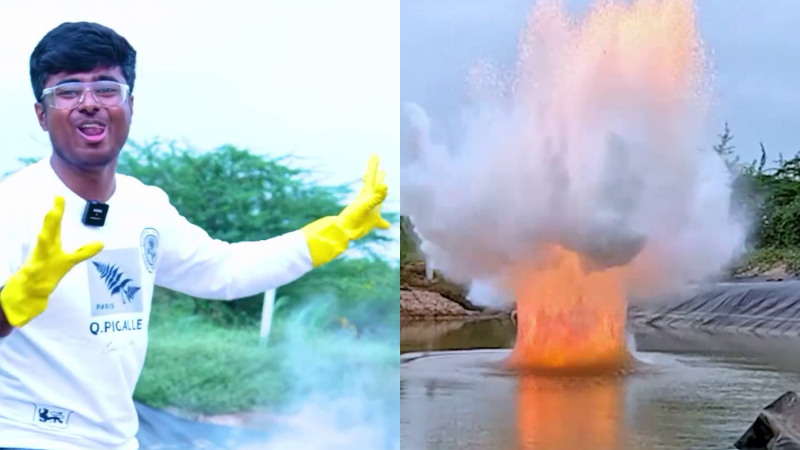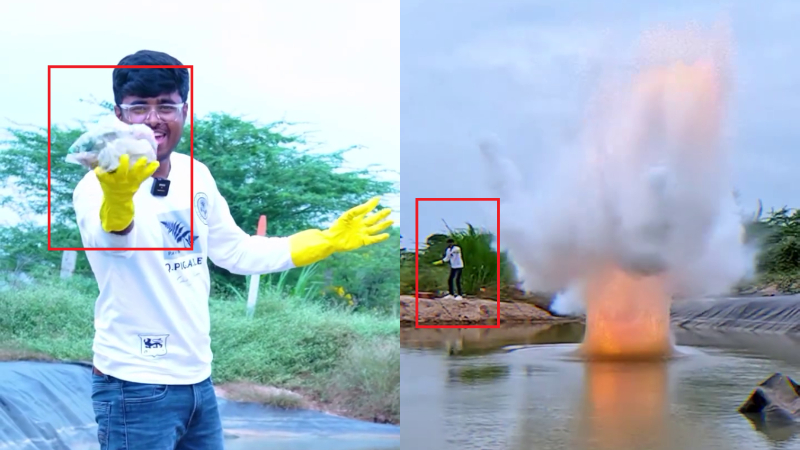Social media influencers often push boundaries to create attention-grabbing content, but sometimes these stunts can cross into dangerous and illegal territory. Such was the case with YouTuber N M Prathap, popularly known as Drone Prathap, who landed in legal trouble after causing an explosion using sodium in an agricultural pond in Karnataka.
The incident, which sparked public outrage, has once again raised questions about the limits of online content creation and the need for responsible behavior among influencers.
The Incident That Led to Drone Prathap arrest
The shocking incident occurred at the Sree Rayara Brundavana farm in Janakaloti, located in Karnataka’s Madhugiri taluk. Drone Prathap, a well-known social media influencer and former Bigg Boss Kannada contestant, uploaded a video showcasing the explosion on his YouTube channel. In the footage, a sodium bomb was detonated in an agricultural pond, resulting in a massive blast that quickly went viral on social media platforms.
As the video spread like wildfire, it sparked intense backlash from viewers, prompting concerns about the dangerous nature of such stunts. Sodium, a highly reactive element, can explode violently when it comes in contact with water, making it particularly hazardous in uncontrolled environments.
The sheer force of the explosion raised alarms, not just about the influencer’s safety but also the potential risks posed to the surrounding environment and nearby residents.
Read : Freakish! YouTuber Makes Guitar with Uncle’s Skeleton and Pays Tribute with Song: Watch
The video drew the attention of local authorities, and soon the Midigeshi police launched an investigation into the matter. Acting swiftly, the police arrested 27-year-old N M Prathap on the evening of December 14, 2024.
The arrest was carried out after officials confirmed that the YouTuber had performed the act recklessly, ignoring the inherent dangers involved. Following his arrest, the video was taken down from Prathap’s YouTube channel.
Bigg Boss contestant #DronePrathap, who sparked outrage after exploding a sodium bomb in a farm pond, was arrested by the Midigeshi police for his reckless act. He was produced before a court and remanded to judicial custody.
— Hate Detector 🔍 (@HateDetectors) December 14, 2024
Drone Prathap had exploded a sodium bomb in an… pic.twitter.com/XE4o2y1h5D
When questioned about his actions, Prathap defended the stunt by claiming it was part of a science experiment intended for promotional purposes. However, authorities refused to take his justification lightly, highlighting the illegality of handling explosive substances without proper authorization.
Legal Charges Under the Explosives Substances Act
Prathap’s actions have serious legal implications, as the use of sodium in an uncontrolled manner amounts to handling hazardous substances.
Based on the viral video evidence, a case was registered against him under multiple sections of the Explosives Substances Act. Additionally, he was charged under Section 288 of the Bharatiya Nyaya Sanhita, which specifically deals with negligent conduct involving explosive substances.
The Explosives Substances Act, a stringent law, prohibits the unlawful handling, manufacturing, or use of any explosive material without appropriate clearance or supervision. Violations of this act carry severe penalties, including imprisonment, as such actions can endanger public safety.

Section 288 of the Bharatiya Nyaya Sanhita also emphasizes penalties for recklessness, particularly when dangerous materials are involved. The explosion not only endangered Prathap’s life but also posed a risk to surrounding wildlife, agricultural resources, and nearby residents who were unaware of the stunt. The case highlights the importance of stricter enforcement of safety protocols when dealing with hazardous substances, especially in rural areas.
Prathap was initially taken into police custody for three days as the authorities gathered further evidence about the incident. After completing their preliminary investigation, he was produced before the court, where the judge remanded him to judicial custody for 14 days.
The arrest sparked mixed reactions across social media. While many criticized Prathap for his reckless behavior, others argued that influencers often face immense pressure to create sensational content to remain relevant. Nonetheless, the general consensus remained that safety and legality should never be compromised for the sake of online views.
The Dangers of Irresponsible Content Creation
Drone Prathap’s arrest serves as a cautionary tale for content creators across the country. As social media platforms continue to grow in popularity, influencers are constantly striving to outdo one another by performing increasingly risky stunts. The pursuit of viral content can often blur the line between creativity and irresponsibility, leading to dangerous consequences.
In Prathap’s case, the use of sodium, a substance known for its volatile reaction with water, highlights a lack of awareness about the potential risks involved.

Sodium explosions generate tremendous heat and energy, capable of causing significant damage to the surrounding area. Agricultural ponds, which serve as crucial water resources for farmers, could have been contaminated or damaged by the explosion. Such reckless acts can also harm aquatic life and disrupt the local ecosystem.
Moreover, incidents like these encourage a dangerous trend where young, impressionable viewers may attempt to replicate similar stunts without understanding the risks.
Influencers hold a position of responsibility, as their content has the power to influence millions of followers. Any act that normalizes unsafe behavior or encourages unlawful activities can have far-reaching consequences.
The incident has reignited debates about the role of social media platforms in regulating content that involves hazardous activities. While platforms like YouTube have guidelines prohibiting dangerous stunts, enforcement of these rules often relies on user reporting and platform moderation. Experts argue that stricter measures are necessary to ensure that such content is flagged and removed before it gains traction.
The arrest of Drone Prathap also underscores the importance of educating influencers about safety, legal boundaries, and ethical content creation.

Many creators, in their pursuit of fame, underestimate the risks associated with stunts that involve explosive substances, fire, or other dangerous elements. Governments and social media platforms must work together to create awareness programs that promote responsible content creation while penalizing those who violate safety norms.
The arrest of N M Prathap, popularly known as Drone Prathap, for causing a sodium bomb explosion in an agricultural pond serves as a stark reminder of the consequences of irresponsible content creation.
While influencers play a significant role in entertaining and educating audiences, their actions must be guided by safety, legality, and ethical considerations. The incident highlights the need for stricter enforcement of laws governing hazardous materials and better content moderation on social media platforms.
As Prathap remains in judicial custody, the case sets a precedent for how authorities will handle similar incidents in the future. It also sends a clear message to content creators: sensationalism should never come at the cost of safety or legality. Influencers must recognize their responsibility to set positive examples for their audiences while avoiding dangerous stunts that put lives and resources at risk.
The incident is not just a lesson for Prathap but for the entire community of digital creators striving to build their platforms responsibly. Content creation is a powerful tool for innovation and expression, but it must always be accompanied by an understanding of its risks and impact.

